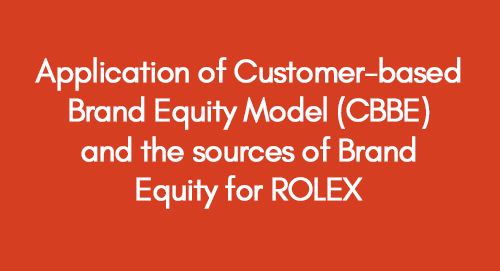
New Health and Safety Technologies in AEC Industry
December 19, 2020
Changing Patterns of Human Resource Management (HRM) in Construction Industry
December 19, 2020 Download PDF File
Download PDF File
The Customer-Based Brand Equity (CBBE) model, often known as the Keller Model, illustrates how a brand's image, as perceived by customers, influences its overall equity and success. It was initially introduced by Keller K.L. in his book "Strategic Brand Management: Building, Measuring, and Managing Brand Equity" in 1997.
How did Chanel develop its beloved brand identity in the UK?
Many prominent global brands, like Rolex, have embraced the CBBE model to enhance their brand equity, focusing on the three crucial factors that impact it, including:
- Achieving a distinct impact through product or service design
- Eliciting a favourable consumer response to marketing efforts
- Establishing robust brand knowledge within the organization
Core Features of Rolex Customer-Based Brand Equity (CBBE) Model
Rolex's CBBE strategy is meticulously crafted and consistently robust in nearly every aspect. The brand prioritises top-tier product attributes and their corresponding narratives, featuring trends and a premium-class image, effectively appealing to high-value prospects.
Luxury Marketing and Branding- An Evaluation under BLI (Brand Luxury Index)
However, various factors impact the brand's equity (Stoner et al., 2014, p. 200), and a better understanding of the brand values, which are detailed in the Customer-Based Brand Equity (CBBE) Model, can certainly influence perceived quality and reliability for the brand.
The following shows the primary CBBE model core elements;
- The Brand's Identity
- The Brand's Meaning
- The Brand's Perception/Image
- The Brand's Resonance/Relationship
The Rolex brand performs well under all specific core elements as per the CBBE model; however, after carefully analyzing the Rolex brand equity, one could contend that optimizing the interrelationships among various brand equity elements is imperative for the Rolex CBBE Model.
The Rolex (CBBE) Model significantly contributes to the growth in profits by enhancing brand equity and customer loyalty.
The Rolex (CBBE) Model Contributes to Profit Growth
A luxury brand such as Rolex, which has one of the best quality and price ratios within the industry, must also emphasise leading human cultures towards a sustainable and healthy way of living. The brand must, in time, integrate the specific CBBE model core elements and establish itself as the leader in a classy and healthy way of living.
Sustainable brand positioning boosts profits by aligning ethics, quality, and higher prices, appealing to modern global consumers. Enhanced brand equity also mitigates stagnation and facilitates growth.
Explore Brand Portfolio Strategies
This CBBE model example presents conclusive points associated with the study;
CBBE model for Rolex (source: information obtained from Davis et al., 2013; Stoner et al., 2014 and various other sources)
Rolex positions itself as a high-quality luxury brand targeting premium customers, but its strength lies in building a strong reputation across all segments of society, maintaining a leading position through performance, brand salience, imagery, resonance, and quality.
Following are the sources of brand equity for Rolex.
Sources of Brand Equity
Before purchasing a luxury product, a meticulous and elaborate decision-making process is set in motion, as elucidated by Torelli et al. (2012, p. 951), highlighting the significance of brand equity models. Typically, acquiring luxury items is driven by the desire to fulfil external needs, such as financial status, social standing, and physical appearance enhancement. Those inclined to opt for such products often base their choices on the external perceptions of others, underscoring the influence of brand equity models.
As a result, a target to achieve social recognition manipulates the inspiration to purchase the product. Nonetheless, it is difficult to determine the likely social effects by evaluating the product by considering the quality features.
Online Co-Creators and Brand Equity
Therefore, branding is the best means for understanding and processing the information regarding the offered alternatives (Han et al., 2013). Rolex has become a synonym for quality assurance, a good reason for a high price and an assurance that the extrinsic objectives of the customers will be fulfilled.
Customer-based brand equity encompasses the dimensions that enable consumers to glean insights into products and aid them in making more informed purchasing choices. Additionally, it fosters a "sense of familiarity" with the product and establishes connections with past buying interactions related to a particular brand (or product). Consequently, this engenders greater consumer confidence, as Davis et al. (2013, p. 100) emphasised.
Brand equity sources can improve the customer's experience with any particular brand. Regular use of brand endorsement and publicity motivates the approval of the product and supports the brand's standing, which leads to a better level of customer satisfaction. Following are the four main sources of brand equity for Rolex;
1. Brand Loyalty
Brand loyalty is a valuable source for assessing the mindsets of customers. Rolex’s clientele fulfils the requirements of both levels of loyalty - i.e., behavioural and cognitive loyalty. It happens because customers will likely prefer this specific watch brand as their primary option and are even ready for a higher initial cost.
2. Awareness About Brand
Another crucial source of brand equity is powerful brand awareness. Rolex is a distinguished and famous luxury brand and a leading player in the luxury watch sector. In the last couple of years, the company has discovered more techniques to fuel brand awareness by means of the revolutionary use of media (Bian & Moutinho, 2011, p. 382).
To boost and sustain powerful brand awareness, Rolex has been using event sponsorships, alliances for donations and many similar activities.
3. Brand Associations
The luxury wristwatch brand is directly linked to expressive and traditional aspects. People want a product that is associated with their personal standards, objectives, desirable social standing and sentiment.
Rolex exemplifies brand salience by providing products that perfectly resonate with consumers' standards (e.g., family beliefs), objectives (e.g., societal status and investment), desired social standing (e.g., items symbolizing prosperity and prestige), and emotions (e.g., personal desires), as detailed by Han et al. (2013, p. 15).
4. Perceived Value
Rolex has placed itself as a conventional design watchmaker; however, it has expertise in scientific and mechanical areas. Rolex sells the goods at a premium price; hence, fields like customer service, trademark, exceptional value and emotional characteristics need maximum focus. The company has targeted customers who want an outstanding ‘treat’ and exceptional design and artistry; hence, a perceived value is very high and should be maintained continuously. It is convenient to endorse a brand that is recognizable by the market and has been launched formally. If Rolex decided to launch a promotional campaign for a new watch, it would be more successful than a preliminary branding activity of a similar company offering identical products.
Effective Loyalty Programs in Building Customer Loyalty
Brand loyalty is a considerable source of creating customer-based brand equity (CBBE). To begin with, it can decrease marketing overheads as it is convenient to maintain existing satisfied clientele instead of targeting new potential customers. The loyal clientele will likely suggest specific products to new prospective consumers, increasing brand awareness (Pina et al., 2013, p. 1413).
Moreover, loyal clientele offers a steady source of revenue, which leads to higher earnings and constancy for the company. Besides, it also assists in getting time to respond to the actions of rival brands since loyal customers are not simply jumping towards rival products.
These sources of brand equity have allowed Rolex to develop and expand into various segments. The brand equity of Rolex has opened all doors for its manufacturing facilities. Most prominent auctions have Rolex endorsing its products since it forms a connection with its clientele that only good, high-quality products will be sold. In addition, strong brand equity generally leads to better placement of products as well as better slots during media adverts.
All in all, brand equity provides a powerful competitive lead to Rolex. Brand characteristics, for instance, custom and tradition, form entry barriers for newcomers. Since Rolex has been operating in the luxury watch industry for over a century, aspects such as custom and tradition are tied to the brand; hence, a newly formed luxury watch business could not match these characteristics even if it produced completely matching watches.
 Download PDF File
Download PDF File
References
Bian, X., & Moutinho, L. (2011). Counterfeits and branded products: effects of counterfeit ownership. Journal of Product & Brand Management, 20(5), 379-393.
Davis, C., Kahler, J., Moran, P., & Liu, X. (2013). Tiger Woods Now Wears Rolex. Journal of Case Studies, 31(1), 96-109.
Han, Y. J., Nunes, J. C., & Drèze, X. (2013). Signalling status with luxury goods: The role of brand prominence. International Retail and Marketing Review, 9(1), 1-22.
Pina, J. M., Riley, F. D. O., & Lomax, W. (2013). Generalizing spillover effects of goods and service brand extensions: A meta-analysis approach. Journal of Business Research, 66(9), 1411-1419.
Stoner, J. L., Torelli, C. J., Monga, A. S. & Swaminathan, V. (2014). The Complex Role of Brand Meanings in Shaping Consumers’ Responses to Brands. Advances in Consumer Research, 42(10), 192-222.
Torelli, C. J., Monga, A. B., & Kaikati, A. M. (2012). Doing poorly by doing good: Corporate social responsibility and brand concepts. Journal of Consumer Research, 38(5), 948-963.
Get 3+ Free Dissertation Topics within 24 hours?




























